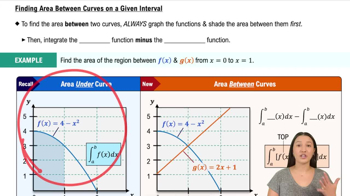Determine the area of the shaded region in the following figures.
Table of contents
- 0. Functions7h 54m
- Introduction to Functions16m
- Piecewise Functions10m
- Properties of Functions9m
- Common Functions1h 8m
- Transformations5m
- Combining Functions27m
- Exponent rules32m
- Exponential Functions28m
- Logarithmic Functions24m
- Properties of Logarithms36m
- Exponential & Logarithmic Equations35m
- Introduction to Trigonometric Functions38m
- Graphs of Trigonometric Functions44m
- Trigonometric Identities47m
- Inverse Trigonometric Functions48m
- 1. Limits and Continuity2h 2m
- 2. Intro to Derivatives1h 33m
- 3. Techniques of Differentiation3h 18m
- 4. Applications of Derivatives2h 38m
- 5. Graphical Applications of Derivatives6h 2m
- 6. Derivatives of Inverse, Exponential, & Logarithmic Functions2h 37m
- 7. Antiderivatives & Indefinite Integrals1h 26m
- 8. Definite Integrals4h 44m
- 9. Graphical Applications of Integrals2h 27m
- 10. Physics Applications of Integrals 3h 16m
- 11. Integrals of Inverse, Exponential, & Logarithmic Functions2h 34m
- 12. Techniques of Integration7h 41m
- 13. Intro to Differential Equations2h 55m
- 14. Sequences & Series5h 36m
- 15. Power Series2h 19m
- 16. Parametric Equations & Polar Coordinates7h 58m
9. Graphical Applications of Integrals
Area Between Curves
Problem 6.2.41
Textbook Question
Find the area of the region described in the following exercises.
The region bounded by y=2 / 1 + x^2 and y=1
 Verified step by step guidance
Verified step by step guidance1
Step 1: Identify the region to be analyzed. The region is bounded by the curves y = 2 / (1 + x^2) and y = 1. To find the area, we need to determine the points of intersection between these two curves by solving the equation 2 / (1 + x^2) = 1.
Step 2: Solve the equation 2 / (1 + x^2) = 1 to find the x-values where the curves intersect. Multiply through by (1 + x^2) to eliminate the denominator, resulting in 2 = 1 + x^2. Rearrange to find x^2 = 1, and solve for x to get x = ±1.
Step 3: Set up the integral to calculate the area. The area is given by the integral of the difference between the upper curve (y = 2 / (1 + x^2)) and the lower curve (y = 1) over the interval [−1, 1]. The integral expression is: ∫[−1, 1] [(2 / (1 + x^2)) − 1] dx.
Step 4: Break the integral into simpler parts. Rewrite the integral as ∫[−1, 1] (2 / (1 + x^2)) dx − ∫[−1, 1] 1 dx. The first term involves the integral of 2 / (1 + x^2), which is a standard integral, and the second term is the integral of a constant.
Step 5: Evaluate each integral separately. The integral of 2 / (1 + x^2) dx is 2 arctan(x), and the integral of 1 dx is x. Combine these results and evaluate them at the bounds x = −1 and x = 1 to find the total area.
 Verified video answer for a similar problem:
Verified video answer for a similar problem:This video solution was recommended by our tutors as helpful for the problem above
Video duration:
5mPlay a video:
Was this helpful?
Key Concepts
Here are the essential concepts you must grasp in order to answer the question correctly.
Definite Integrals
Definite integrals are used to calculate the area under a curve between two points on the x-axis. In this context, the area between the curves y = 2 / (1 + x^2) and y = 1 can be found by integrating the difference of these functions over the interval where they intersect.
Recommended video:

Definition of the Definite Integral
Finding Points of Intersection
To determine the area between two curves, it is essential to find their points of intersection. This involves setting the equations equal to each other and solving for x, which provides the limits of integration necessary for calculating the area.
Recommended video:

Critical Points
Area Between Curves
The area between two curves is calculated by integrating the upper function minus the lower function over the interval defined by their points of intersection. This method allows for the accurate determination of the enclosed area, which is crucial for solving the given problem.
Recommended video:

Finding Area Between Curves on a Given Interval

 5:23m
5:23mWatch next
Master Finding Area Between Curves on a Given Interval with a bite sized video explanation from Patrick
Start learningRelated Videos
Related Practice
Textbook Question
29
views
